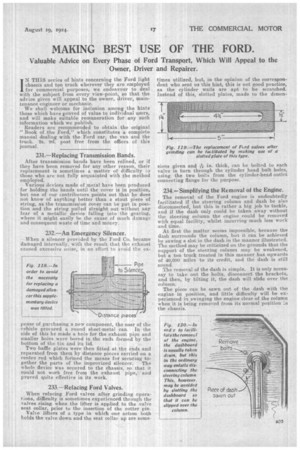MAKING BEST USE OF THE FORD.
Page 17

If you've noticed an error in this article please click here to report it so we can fix it.
Valuable Advice on Every Phase of Ford Transport, Which Will Appeal to the Owner, Driver and Repairer.
IN THIS series of hints concerning the Ford light chassis and ton truck wherever they are employed for commercial purposes, we endeavour to deal with the subject from every view-point, so that the advice given will appeal to the owner, driver, maintenance engineer or mechanic.
We shall welcome for inclusion among the hints those which have proved of value to individual users, and will make suitable remuneration for any such information which we publish. Readers are recommended to obtain the original " Book of the Ford," which constitutes a complete manual dealing with the Ford car, the van and the truck. 2s. 9± post free from the offices of this journal.
231.—Replacing Transmission Bands.
After transmission bands have been relined, or if they have been removed for any other reason, their replacement is sometimes a matter of difficulty zo those who are not fully acquainted with the method employed.
Various devices made of metal have been produced for holding the bands until the cover is in position, but one of our contributors points out that he does not know of any-thing better than a stout piece of string, as the transmission cover can be put in position and the string pulled straight out without any fear of a metallic device falling into the gearing, where it might easily be the cause of much damage and consequent waste of time and money.
232.—An Emergency Silencer.
When a silencer provided by the Ford Co. became damaged internally, with the result that the exhaust caused excessive noise, in an effort to avoid the ex pense of purchasing a new component, the user of the vehicle procured a round sheet-metal can. In the side of this he made a hole for the exhaust pipe and smaller holes were bored in the ends formed by the bottom of the tin and its lid.
Two baffle plates were then fitted at the ends and reparated from them by distance pieces carried on a centre rod which formed the means for securing to
gether the parts of the imorovized silencer. The whole device was secured to the chassis; so that it could not work free from the exhaust pipe, and proved quite effective in its work.
233.—Refacing Ford Valves.
When refacing Ford valves after grinding operations, difficulty is sometimes experienced through the valves rising when the lifter is applied to the valve seat collar, prior to the insertion of the cotter pin.
Valve lifters of a type in which one action both holds the valve down and the seat collar up are some
times utilized, but, in the opinion of the correspondent who sent us this hint, this is not good practice, as the cylinder walls are apt to be scratched. Instead of this, slotted plates, made to the dimen sions given and -Ain. thick, can be bolted to each valve in turn through the cylinder head bolt holes, using the two bolts from the cylinder-head-outlet connecting flange for the purpose.
234.—.Simplifying the Removal of the Engine.
The removal of the Ford engine is undoubtedly facilitated if the steering column and dash be also disconnected, but this is rather a big job to tackle, and if the dash only could be taken away without the steering column the engine could be removed with equal facility, whilst incurring much less work. and time.
At first the matter seems impossible, because the dash surrounds the column, but it can be achieved by sawing a slot in the dash in the manner illustrated. The method may be criticized on the grounds that the supportof the steering column may be weakened, but a ton truck treated in this manner has upwards of 40,000 miles to its credit, and the dash is still sound.
The removal of the dash is simple. It is only necessay to take out the bolts, disconnect the brackets, and then, by tilting it, the dash will slide over the column.
The piece can be sawn out of the dash with the engine in position, and little difficulty will be experienced in swinging the engine clear of the column when it is being removed from its normal position the chassis.






























